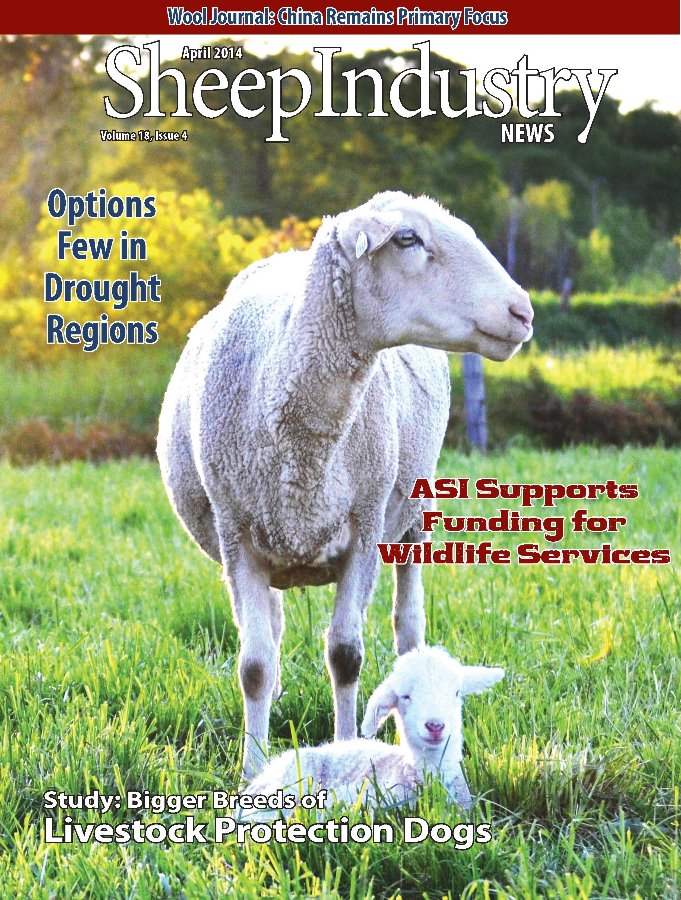
- April 2014
- President’s Notes
- Market Report
- ASI Takes Lead in Supporting Funding for Wildlife Services
- Larger LPD Breeds Being Considered
- Ranchers and Producers Affected by Drought Looking for Options
- States Release Wolf Reports, as Required by Feds
- Helping the Outdoor Industry ‘Rethink the Way it Sees Wool’
- Sheep Producer and Artist
- From Sheep Farm to Farm Bill
- Black Hills Stock Show Sheep Shearing Contest
Helping the Outdoor Industry
‘Rethink the Way it Sees Wool’
Duckworth’s Plan to Use American-Grown Wool Begins at Helle Rambouillet
COURTNEY HOLDEN
SNEWS
Few companies in the outdoor arena can say their product is made from start to finish on American soil, but that’s what industry newcomer Duckworth plans to stake its claim on. Well, that and a highquality product that aims to make the outdoor industry rethink the way it sees wool.
“It’s like single-origin coffee. It’s source verified, single-origin wool,” Duckworth President and Co-Founder Rob Bernthal said. “We’ve created an entire range of products from one sheep ranch.”
Duckworth’s wool apparel items are U.S. grown, spun, knit and sewn, a system with benefits Bernthal ticks off easily: fibers with natural stretch, more U.S. jobs, less travel in the supply chain, and stitching technology unavailable overseas.
“My partner Graham Stewart and I are veterans of the wool industry. We founded a brand called I/O, a merino wool company, back in 2005 that used Australian wool manufactured in China. After that experience we were looking to do it all in the States,” Bernthal said. “We knew there was very fine wool in the U.S. — a supply of 18-19 micron, triple A, fine merino wool — but not a lot of it.”
The search for the perfect wool ended when Bertha and Stewart met John Helle, a fourth generation rancher who shared the same vision as the Duckworth founders. Helle also loves to ski (Bernthal calls him a “ripper”), which only boosted the rancher’s qualifications. Based in Bozeman, Mont., the sheep that produce the 100 percent Helle Rambouillet wool graze on the open range of Montana mountain pastures.
“It gives us a huge amount of satisfaction to create jobs in the U.S., including in Bozeman. When our rancher adds another 1,000 head of sheep, it all helps the American economy,” Bernthal said.
Once shorn, the wool is sent off to be turned into yarn and woven into garments. Duckworth’s wool goes to South Carolina, rather than across the globe to a mass textile producer in China or Malaysia. “Our wool travels 2,000 miles. We just cut 20,000 miles out of the supply chain,” Bernthal said.
Not only is the South Carolinian factory much closer, it also has the machinery to “recreate these classic fabric constructions that we would never do off shore,” including the waffle stich, a more insulative, yet breathable pattern from which many of Duckworth’s wares find inspiration.
Another benefit of using American wool: the fibers have more crimp, a trait that has been bred out of New Zealand wool. The latter fibers are long and straight, almost polyester-esque, whereas wool from the U.S. has similarly long fibers, but with significant waviness, which adds elasticity, strength and loft.
That extra tug means Duckworth doesn’t have to add Lycra to its products in order to attain that fits-just-right feel.
With so much attention paid to the seemingly straightforward process of developing yarn, it’s no surprise that Duckworth puts even greater effort into new technology. “‘Made in America’ is not enough reason to buy Duckworth,” Bernthal said. “I consider us the leaders in wool technology. We have the most new fabric constructions and development. Buy American because it’s the best … that’s what we strive for. We want to be America’s best wool company.”
In addition to its baselayers and midlayers, the brand’s patent-pending “WoolCloud” is a down fill alternative for outwear that doesn’t clump, resists wetness, makes use of what would otherwise be waste materials.
“The warmth-to-weight proportions [of WoolCloud] are fantastic. It has great heat retention, and it’s much more predictable and manageable in the garment stage,” Bernthal said. And we’re “using a recycled wool in a fill. It makes a lot of sense to us.”
Duckworth’s wool baselayer program brings back what Bernthal calls a “lost art”: using wool as a first or second layer instead of something synthetic.
The brand will introduce five different fabric constructions, including the ultralight Micro Rib 140, versatile Power Jersey 160, light and warm Quattro Waffle 165, high-wicking Hydro-Ply 200 and cozy Dura- Fleece 220.
“It looks good. It’s all-natural. It doesn’t smell. And it feels as good as a sweater,” Bertnhal said. “We’re really wool technologists. Not only are we a made-in-the-USA story, but we’re really wool specialists, more so than any other company.”
The Duckworth name, and its motto “Acta non verba”—which translates to “action, not words”— hearkens back to “a time when people lived in the outdoors.”
“It’s not just being an extreme, rad mountain dude. We like to know our backyard,” Bernthal said. “We really use this (product). Everyone in Duckworth lives in wool everyday. It makes a big difference.”
Duckworth’s first product delivery is scheduled for fall 2014. The brand plans to only sell to specialty retailers, “individual shops who are putting out a retail experience,” and perhaps on its website at a later date.

